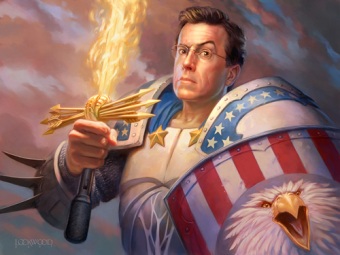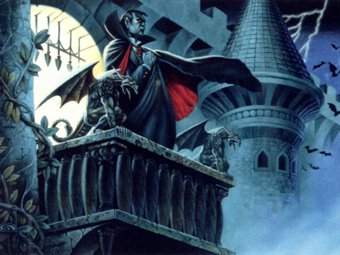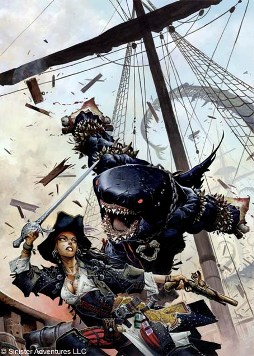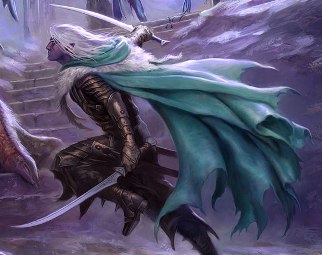Art of the Genre: Is Digital Art Real Art?
I’ve often been asked ‘how cool is it to have all that original art from the Art Evolution Project?’ or ‘What will you do with all that original art?’ I tend to smile when I hear it because it somehow means that I know more than most where the world of art is concerned. The primary thing would be that the bulk of artists don’t give up originals these days unless you are willing to pay a king’s ransom for them, and the secondary is that much of the work done for me in the project was at least ‘touched’ by a computer or fully rendered in a digital format. The reality is that the original is not the piece you see, assuming there is even ‘hard’ original to begin with. 
That in itself is a testament to the changing landscape of art and the power of the computer when used in the process of creation. Still, it leaves many people feeling a bit hollow, the new inability to own an original because only an artist’s hard drive has the capability for that. The computer also rocked the art field as the backlash from the lack of original hard art begging the question ‘is digital art, ‘real’ art?’
Everyone who is anyone has an opinion on this, and certainly one of my favorite views on the subject comes from Lazarus Chernick in his WordPress blog that can be found here, but instead of trusting the husband of an artist, I went out and got three well known artists to address the subject.
The following are responses to the question of digital art being real art.
Clyde Caldwell [Is a full traditionalist, no digital work in his portfolio]
I’m only a “traditional holdout” in the sense that I’m close to the end of my career and figure I can ride into the sunset still painting the way I like to paint…traditionally. If I were younger and wanted to stay in the fantasy art field, I’d definitely have to learn to paint digitally.
The computer is a tool in the same way that a paint brush or a pencil are tools. It’s just a means to an end…and the end is the creation of an image. I’ve been told that digital art is easier and faster to produce, and those are positives when you’re fighting a deadline and/or trying to make a living producing art. 
The only thing I have against digital art is that you don’t have an original at the end of the process. I like to have a one of a kind, original piece of artwork that I can hold in my hands, sell…or hang on my wall. For me, that’s the main drawback to working digitally.
It’s funny, because lately I’ve heard quite a few digital artists lamenting the fact that they really miss working traditionally, and would like to get back to it. I think there’s some elusive satisfaction in working with traditional media that may be missing in the digital realm.
But in the end, in my opinion, digital art is “real art”, if you classify illustration as “real” art. But that’s a question for another day!
Wayne Reynolds [Does not do any digital art, even including ‘touch ups’ and he is considered the most ‘modern’ artists of these three]
I am of two minds regarding digital art. More and more artists are turning towards digital rendition. Artists that work in traditional mediums are now in the minority. Many traditional artists are now touching up and enhancing their artwork digitally. Even though there is no hard copy to a digital image I’m of the opinion that it is still ‘real’ art.
A graphics pen on screen is just as valid a medium as oil on canvas. However, I prefer digital artists who work from scratch. There are many digital artists that let the machine do the work for them and very little of their talent shows through because they’re relying on the art functions to do the work for them. Similarly, many computer artists use photographs in their work and ‘paint’ on top of them. Sometimes this can be done to produce some amazing pieces of work and sometimes the results are appalling as the artist’s ability to paint doesn’t match the realism of the photograph. If artists take their own photographs the finished piece is still an original piece of art. 
William O’Connor and Raymond Swanland are particularly good examples of my favorite kind of digital artist. These are two artists that don’t use photographs, texture fill, gradient or any other electronic program other than a pure painting function. When Bill made the switch from traditional techniques to digital techniques, I couldn’t tell the difference. He’s still kept the same style of work that is recognizably his. I think Todd Lockwood’s just recently gone all digital with similar results. He paints digitally the same way he paints traditionally.
Todd Lockwood [Made the switch to digital art in around 2003, although he has said that 2011 will bring him more non-digital commissions than he has ever had in his life]
I am often asked if digital art can rightly be called Art. Many people expect Art to be a tangible thing, a singular object that can be collected and held, traded like a commodity, sold or resold, or simply hung and enjoyed as the single best version of that image, superior to the printed cover or art book reproduction. But they are confusing Art with the material object itself, the definition of which has been made difficult by the intrusion of computers into what was previously one of the last bastions of old-style craftsmanship.
The Art does not reside in the thing. You could not hang Eric Clapton’s guitar on your wall and say that you owned “Layla.” If a tree falls in the forest and no one is there to hear it, does it make a sound? Can a dog look at a Picasso and appreciate what it sees? What separates a string of random sounds from a symphony? What makes a concoction of linseed oil and ground up minerals, smeared on a canvas, a painting?
Each of the Arts has a Medium, or Media. With music it is the instrument of choice, or perhaps the material your recording was applied to. With a painting it is the choice of oils or watercolor, pastels or acrylic. A sculptor chooses his stone. According to Merriam Webster, Media is something in a middle position— a go-between, an intermediary. It is a means of effecting or conveying something; a channel or system of communication, information, or entertainment; a mode of artistic expression or communication.
Communication.
Without two minds, creator and audience, there is no communication.
Good art gives you a glimpse into the inner workings of the artist’s mind and elicits a response. It reveals things you might not have seen on your own. It conveys an idea or evokes an emotion. It tells a story or expresses an opinion. It draws the viewers or listeners in and encourages them to return again and again. 
Without that interaction, a print of a great painting, a recording of a brilliant symphony, a televised play, or almost any variety of movie would be worthless. Photos of Frank Lloyd Wright’s Falling Water would not impress. Christo’s fabric draped buildings would have no meaning.
What separates Art from not-art is not the medium, but the vision.
In the past, great art also produced a singular product—a painting—that is true. But bad art also produced a product. What made the better art outstanding was not the board it was painted on or the type of paint that was used, but the message it conveyed. The art happens between minds, the artist’s and yours. The mere existence of paint on canvas or pixel on monitor does not create art. It is the communication that makes it so.
It is the lack of a singular original that causes critics to deride digital art, and not entirely without reason. It is one of the sad facts of digital paint that there is no true original other than the image on the artist’s computer screen, where the colors and values are closest to his vision. With an original oil painting, it is possible to see the hand of the creator at work. You can peer closely and analyze the layers, see the brush strokes, step back and admire the whole, then lean in again for another detailed discovery. An original painting has levels of enjoyment that no print of it can approach. A large painting can have an impact that few printouts can hope to come near.
But very few people get to see originals of anything in this day of DVDs, CDs, art books, movies, and TV. Some art forms are more ephemeral than others. A ballet production or a jazz performance relies on the instant. When the performance is over, the “original” is gone forever. Any recording is but a doppelganger. One might even argue that any performance following that directed by the original creator is a mere shadow of the true vision. Every copy of a first-run movie is identical, all made from the same master. There is no one original, or there are many.
Yet people buy these reproductions by the millions. A recorded song, a painting in a dark room, a file on a disc; all have the same potential to do their magic again and again and again.
It is image, not surface, that matter.
Art is an event that happens between two persons. One creates, and the other experiences the creation. The painting is only the go-between, the intermediary between one mind and another. A digital painting program is a medium, no more and no less. If people respond to the art that is created with it, then of course it is art.
Three artists from three different time periods of art, each working in a different medium but all basically saying the same thing, that art is art. I for one agree, and yet there does seem to be a loss involved digitally, as though the world has somehow been denied something that it would have otherwise had. Originals, however, have long since been as much about bragging rights as true appreciation, so a part of me is more than willing to let them go.
Oh, and for any of those wondering, I do have six originals from Art Evolution of the twenty-two Lyssa images produced so I guess that’s something!
It’s nice to see that artists in the field don’t share the technophobia that critics seem to feel! What thoughtful responses, I like all three of them.
I agree with the sentiment that the danger of the digital medium is no greater than any other. Artists who are not fully masters of whatever style they have chosen, yet, or who are less interested in spending the time necessary to start from scratch, are going to take shortcuts where they can, regardless of the type of canvas they are working with. Their art will not have the same polished look that artists who are working or have worked to master their craft do.
I think it’s also important to remember that we people who buy art are not likely to be as capable of seeing the faults in a bad artist’s work as a trained artist would be. Our personal attraction to a certain style over others may make us choose a seemingly bad artist simply because we are taken with that particular artist’s style, regardless of form.
Not all art can be done digitally, either. The first thing that comes to mind is sculpture. As a collector and staunch supporter of functional art, too, I have to say my market of interest is in absolutely no danger. No matter how expertly a computer can reproduce the sound or look of an intricately carved pan-flute, it isn’t actually a pan-flute unless it’s a physical object.
The mass-reproduction problem exists for every medium, though. The pan-flute in my example might be handmade but it could just as easily be one of hundreds made through a streamlined factory process. If something’s relatively easy to get, you will probably find that it was relatively easy to make, too. It seems like those art collectors who want an original painting could to go back to the old-fashioned mode of getting them: pay a handsome sum to commission a painting by your favorite artist(s)! That could be a very rewarding way to support traditional art while adding to one’s collection.
Lydia: Love that you’ve come back! A great comment indeed. It is a slippery slope, but I think the artists involved have the correct idea.
[…] Black Gate » Blog Archive » Art of the Genre: Is Digital Art Real Art? […]
I remember reading from one of H.R. Giger’s books. He had a problem that the art community did not accept the “Airbrush” as a real artist’s tool. Well, he pointed out one time returning to France he was pestered by a customs official that he owed some taxes for bringing in “Photographs”. Meaning his art, the name alone describes the subject…
He was flattered beyond words. For the most part, only Picasso could do things realistically enough to fool anyone it was a photograph. And with Giger’s stuff, he joked “where was I on vacation to take such pictures, H-ll!?”
GG: Love that story! Giger is too funny.
[…] Is Digital Art Real Art? […]